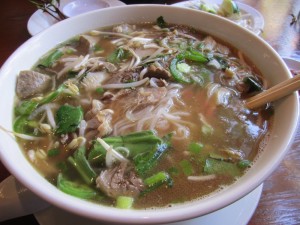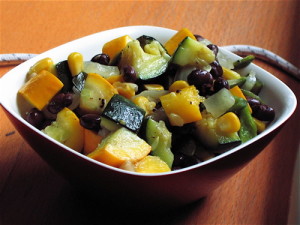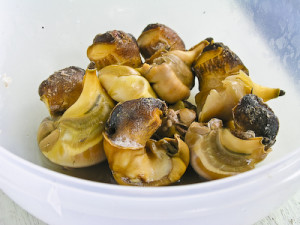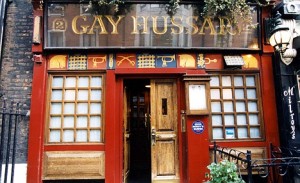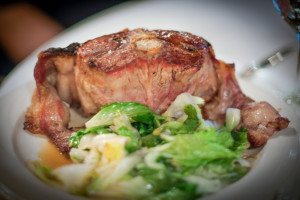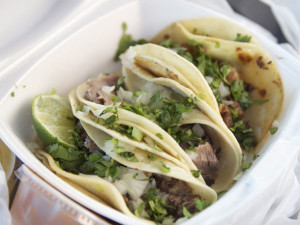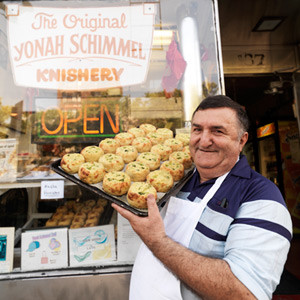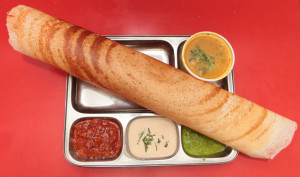Oh, joy!! In the chilly weather of early Spring (or any weather, for that matter) HG longs for a giant steaming bowl of Pho, the glorious Vietnamese noodle soup. (Apologies to my beloved late Mom: Your chicken soup was great but Pho is even better). HG has bewailed the lack of Pho in Santa Fe. Then, early this week, HG discovered the very plain spoken Saigon Cafe, a family owned and operated little restaurant on Cordova Street. Topping the menu was Pho Bo, a Pho with beef and rice noodles. HG was misty eyed as he surveyed a very big bowl and a platter of fresh mint, bean sprouts and sliced jalapeno peppers. The broth was powerful and flavorful. The noodles were properly al dente with great mouth feel. Lots of thinly sliced tender beef as well as some Vietnamese sausage. As good as any Pho HG ever tasted in New York, Vancouver or Denver’s Federal Boulevard (home to a score of good Vietnamese restaurants). HG will become a Saigon Cafe regular. There are about 20 Pho variations on its menu (including a very fiery chicken Pho with a curry base.) The menu also has about a dozen variations on chow fun (wide noodles) and egg noodle lo mein. Everything is modestly priced. Slightly more expensive is shrimp cooked in a clay pot and catfish in hot and sour soup. Intend to try everything.
Saigon Cafe Answers HG’s Prayers
March 25th, 2015 § 0 comments § permalink
Sunday Health Food – El Parasol Style
March 10th, 2015 § 0 comments § permalink
Sunday. That’s the day when HG gathers the week’s accumulation of garbage, newspapers, bottles, magazines, junk mail and drives it off to the nearby Pojoaque Waste Disposal Facility a.k.a. The Dump. A few Sundays back, it was cold with a hint of snow in the air. (No, not the murderous East Coast freeze but cold enough to chill aged HG). So, after the weekly chore it was off to warm and friendly El Parasol in Pojoaque. Earthy, down home New Mexican cuisine. HG’s favorites have long been El Parasol’s menudo, posole and arroz con pollo. Some time ago, HG mentioned to the proprietor Jose Atencio, a very genial and efficient host, that it would not be amiss if he added some vegetarian dishes to the menu. This might prove particularly attractive to the vegetarian Sikhs who live close to El Parasol in large ashrams, reasoned HG. And, so it came to pass. Señor Atencio now provides vegetarian enchiladas plus a very lush chile relleno burrito. On this frigid Sunday, surrounded by joyous Hispanic families, HG dug into the health food dish supreme: A Calabacitas burrito smothered in fiery real deal New Mexico green chile sauce. The big flour tortilla was stuffed with zucchini, yellow squash, corn and a bit of onion. A lusty layer of cheddar cheese was added, Rolled up and heated, the burrito put on a heavy overcoat of El Parasol inimitable green chile. Farewell, cold. Hello, savory satisfaction.
The Gay Hussar
March 5th, 2015 § 0 comments § permalink
Troubling news from London. The future of The Gay Hussar, one of HG’s favorite restaurants, is in jeopardy. The hotel group that owns The Gay Hussar claims the restaurant has been losing money for some years. They are threatening to close it down. As HG has written in an earlier post (“Perfect London Days (and Nights)”), the restaurant has long been the favorite dining spot for Britain’s Labor Party and various left wing journalists. Patronage fell off during Tony Blair’s administration. (Blair’s two sins were his support of the grossly ill-advised Iraqi War and his advocacy of “health” food). However, there’s hope. A Labor Party group is busily raising money to buy the restaurant. If successful, a spokesman said, they will offer more “light” dishes on the menu. HG’s advice: Don’t change a thing. Everything about The Hussar is perfect: The decor, the lighting, the comfortable seating and the super hearty Hungarian cuisine. HG would often start luncheon there with fish dumplings in a creamy dill and mushroom sauce. Greedy HG would then have a requested half portion of the fried mushrooms with tartar sauce appetizer. Main dish was duck livers sautéed with bacon, onions and paprika. Dessert: Chestnut puree with dark rum and whipped cream. Fruity Hungarian red wine with the meal and powerful Hungarian brandy as a digestif. (HG’s luncheon companion, BSK, ate and drank more modestly and turned down dessert in favor of strong coffee). After lunch, a long stroll through one of London’s beautiful parks was in order. Then a brief rest and a hot shower before theater. Check out The Gay Hussar website for the current menu. HG prays the restaurant stays open and unchanged so HG can overeat during a planned autumn London visit.
“Where The Finest Jews Eat”
March 1st, 2015 § 2 comments § permalink
For many years that was the motto of Moskowitz & Lupowitz, a Romanian-Jewish restaurant on Second Avenue and Second Street in New York. It was a favorite of Groucho Marx, Milton Berle, Eddie Cantor, Sid Caesar and other theatrical luminaries. It was founded in 1909 by Romanian immigrants and for many years was owned and managed by Louis Anzelowitz until finally closing in 1966. It was one of HG’s favorite New York restaurants, offering a robust array of artery clogging traditional Eastern European Jewish dishes. (The loud Sammy’s Romanian on Chrystie Street is the last of the Romanian Jewish restaurants on the Lower East Side. Its menu is a pale shadow of the wonders once offered by M & L). When HG was a child M & L loomed large in HG’s imagination as he often heard their catchy jingle being sung by the Pincus Sisters on the Yiddish language radio station WEVD (named after socialist Eugene Victor Debs). M & L was the classiest Lower East Side restaurant with waiters in tuxedos and thickly carpeted floors. Despite the elegant atmosphere, it was never very expensive. In 1940 you could have a five course steak dinner for $1.35 (fruit juice, appetizer, soup, main dish, dessert). In 1962 you could have this meal for about $4.50. HG’s cardiologist would not have approved of HG’s typical M & L meal: Brains, sweetbreads, chicken livers or chopped liver with chicken fat and onions as an appetizer. This was followed by chicken soup with “kreplach” (meat filled dumplings). Main course was an M & L specialty: “Mushk” steak (rib steak) with “kasha varnishkes” (buckwheat groats with Farfalle pasta, fried onions and chicken fat.) Dessert was an afterthought: Stewed prunes (for digestive purposes). HG drank vodka with the appetizers, beer with the main course and Slivovitz (plum brandy) as a digestif. Plus Russian tea (strong black tea with a spoonful of cherry jam). HG often went to M & L with a stylish girl friend who ordered four appetizers as a meal (they had to be brought in succession by the waiter who grumbled as he made trips to the kitchen). The lady washed them down with Wild Turkey bourbon on the rocks. Pre-World War Two Lower East Side had many “Romanian broilings” restaurants. When little HG accompanied his father to that neighborhood to buy HG a winter outfit (heavy plaid mackinaw, corduroy knickers, cap with attached earmuffs) the two often would visit these joints to lunch on broiled “karnezelach” (beef, garlic and onion cigar-shaped hamburgers) with crisp “silver dollar” potatoes. At night, these places would transform and often featured a violinist playing Yiddish and Gypsy melodies. Italian mobsters and their Jewish gangland associates loved these rough and ready eateries. They were known as “Jew joints.” The bad guys never patronized Moskowitz & Lupowitx. Too classy. Too bourgeois. A “carpet” joint.
Scungilli
February 27th, 2015 § 0 comments § permalink
The dictionary defines scungilli as “a large marine whelk or conch eaten as food.” Yes, this was a protein–in the form of salad or mixed with pasta smothered in super-hot red sauce–that was served in many old fashioned New York Italian restaurants during HG’s youth. The sea creature was pronounced “skoonjeel” and was delicious. Scungilli mostly disappeared from Manhattan menus and soon could be found in only two restaurants in Little Italy–traditional Vincent’s and upstart Umberto’s. In HG’s opinion the best fiery scungilli pasta dishes were found in a tiny Italian joint in Chinatown (corner Mott and Pell). HG ate there with two rugged Goodfellas who solicited HG’s promotional advice on how to improve sales at their legitimate front –a Staten Island furniture store. (Of course, scungilli was always available in Brooklyn, the Corona and Howard Beach neighborhoods of Queens and in the beloved Belmont Tavern, Belleville, New Jersey). Scungilli had its big moment of fame when gangster Crazy Joe Gallo was murdered at Umberto’s Clam House on April 7, 1972. (Scungilli, presumably, was on the table when he met his end.) Crime analysts have wondered why Gallo was dining at Umberto’s rather than the more traditional Vincent’s. HG has a theory: Joe was sentimental and his father, also a gangster, was named “Umberto.” Recently, a hungrygerald.com follower informed HG that there’s a very good Italian scungilli restaurant in Vero Beach, Florida. HG will keep it in mind if he ever ventures into Jeb Bush territory.
Perfect London Days (and Nights)
February 25th, 2015 § 1 comment § permalink
In the early 1970’s, HG assisted the management of New York’s posh Hotel Pierre in solving a sticky public relations problem. The Pierre was part of the Forte international hotel group. This meant HG/BSK got a special rate when they stayed at Forte’s Brown’s Hotel in the Mayfair neighborhood of London. Brown’s was quiet and genteel. The rooms had no television or other of today’s electronic necessities. Furniture was vaguely art deco. Bathrooms were spacious with large tubs and powerful hot water showers. Comfy beds and sweet smelling sheets. The hotel’s chintz bedecked English Tea room was famous throughout London. HG/BSK breakfasted in their room. Poached eggs. Grilled tomatoes. Wheat toast. Marmalade. Pots of very good tea. Then off to a day of museums, galleries, shops and London architecture. Back to Brown’s for tea at four o’clock. Cucumber and watercress sandwiches. Scones with clotted cream and strawberry jam. Fruit cake. And, of course, superb freshly brewed tea. A brief rest and shower. Off to the theater. (The dollar and pound were in an attractive equilibrium in those days making London affordable). Apres theater HG/BSK dined at the glamorous Savoy Grill. Perfect smoked salmon sliced paper thin. Mixed grill with soufflé potatoes. Their other choice was venerable Rule’s for smoked salmon, Welsh rarebit and vintage Port. At some point, Brown’s got a big time “luxury” modernization. Prices went up and the rooms lost some of their charm. HG/BSK switched to the Wilbraham Hotel near Sloane Square. Eccentric, shabby, genteel, comfortable. HG/BSK eliminated high cal afternoon tea and lunched at such wonderful venues as the Hotel Connaught Restaurant (certainly in its time the best and most beautiful restaurant in the world) and J. Sheekey’s, the seafood restaurant in the theater district. HG’s spot for lunch on a grey, rainy or chilly London day was The Gay Hussar on Greek Street in Soho. A cozy rectangular room bedecked with books, mirrors and political caricatures, The Gay Hussar is the favorite dining venue for Britain’s Labor Party and left wing journalists. While the Labor Party dignitaries may attack the rich in Parliament, they do not disdain rich food. The Hungarian food at The Gay Hussar is decidedly rich, flavorful and hearty. The Wilbraham Hotel allowed HG/BSK to stock their refrigerator with ham, roast beef, chutney and salads from a nearby delicatessen (“By Special Appointment to the Queen Mother”). Thus, HG/BSK had their after theater feast in their room. Drank very good French wines. Yes, those were perfect London days and nights. Can’t be repeated. London is not the same. The unique English flavor of the city has diminished and money crazed internationalism rules.
Mutton Chops
February 24th, 2015 § 0 comments § permalink
If you are a happy carnivore with a taste for robust red meat, there is nothing better than a big, rare mutton chop. Oddly, it is not a celebrated menu item in New York or Paris. (If you search, you can find mutton chops in London). In times past you could find mutton chops at two locations in New York: Keens Chophouse on W. 30th Street and at Gage & Tollner on Downtown Brooklyn’s Fulton Street. Gage & Tollner was founded in 1878 (closed in the 1990’s) and had a mellow antique interior with 38 gas lamps, wood paneling and mahogany tables. The mutton chop was medium in size and served with corn fritters sweetened with a bit of maple syrup. (The combination seemed unusual but it worked). Thankfully, Keens is still in business and their legendary mutton chop is still giant. Prices however are a different story: In keeping with present day oligarchy-influenced New York the chop now fetches $51.00. HG/BSK enjoyed Keens often when they lived on the Upper West Side during the 1960’s.(Prices were much more modest then). Once, during a Boston-type blizzard, HG/BSK ventured out at night, found an intrepid cab, and supped on Keens’ mutton chop, skillet sized golden hash browns and wine. Only two tables in the restaurant were occupied. Keens (founded in 1885) was not only a cold weather choice. On a blazing July day, HG/BSK shopped for baby furniture at Macy’s (baby daughter Lesley was due in August). HG and very pregnant BSK left summer heat behind and had an early dinner of roast beef, fiery horseradish and Yorkshire Pudding at Keens. The beautifully aged restaurant interior was cooled by very modern air conditioners. HG/BSK felt they were dining in late autumn London. Keens now charges $58.00 for its prime rib.
Viva Mexico
February 23rd, 2015 § 0 comments § permalink
In the early days of television (1954) HG and a colleague recently arrived in New York from California, wrote TV news programs that were broadcast nationally. The news was illustrated with still photos (they were called “telops”) which were transmitted by telephone wire to the TV stations (news film was introduced at a later date). HG and his pal were swift and nimble news writers and photo selectors. It was fun. International News Service, the Hearst wire service (later absorbed by United Press) was HG’s employer. INS was housed in the Daily Mirror building on E. 45th Street and HG usually lunched in the hole-in-the-wall Greek diner off the building’s lobby. But, knowing that his California buddy missed Mexican food, HG invited him to lunch at Manhattan’s only Mexican restaurant, Xochitl. A mistake. “This is a bad joke,” he declared in reference to both the food and the high price of lunch. In the 1960’s HG/BSK visited friends in California (their first trip to the state) and were determined to eat “real” Mexican food. Their friends (not foodies) took them to a nearby Taco Bell (then only in California). HG/BSK found it satisfactory but felt there was something missing. HG thought about all of this at a Sopaipilla Factory dinner last night (the eatery is in Pojoaque, New Mexico, a few minutes from HG/BSK’s home). HG/BSK and their visiting eight-year-old grandson, Haru, feasted on menudo, enchiladas, green and red chile of a quality simply unimaginable to a New Yorker of the 1960s. Not so to present-day New Yorkers like grandson Haru, who knocked off a bunch of chicken tacos declaring them to be “awesome” with the caveat that, as a Brooklyn guy who regularly dines in Sunset Park (a Mexican neighborhood near his home), he has devoured many an authentic taco. In fact New York is having such a Mexican food renaissance (with both high end and low down options) that HG’s Californian pal would probably find much to smile about. As part of this renaissance, HG is looking forward to next month’s opening of Rosie’s, Restaurateur Daughter Victoria’s next New York restaurant. This will feature farm-to-table Mexican cooking. (Husband/chef Marc Meyer has just returned from a two-week visit in Mexico with Diane Kennedy, the ultimate authority on Mexican cuisine). Meanwhile, HG will be off to nearby El Parasol to give visiting Haru another taco fix.
The Knish
February 12th, 2015 § 0 comments § permalink
The Knish is an Eastern European street food introduced to the United States by turn of the century Jewish immigrants from Belorussia. The Knish is a flaky pastry filled with a variety of stuffings—potato, kasha (buckwheat groats), spinach, cheese. A famous name in knishes (and loan-sharking…but that is another story) is Yonah Schimmel. Yonah began selling knishes from a pushcart on New York’s Lower East Side in 1890. The Yonah Schimmel knish bakery has been at its present location on East Houston Street since 1910. (There seems to be a spelling confusion. The big sign on the store says “Yonah Shimmel” even though the correct spelling is “Schimmel.”) Another top knish baker (alas, departed) on the Lower East Side was a woman named Gussie Schwebel who ran an eponymous knishery near Schimmel’s on Houston Street. Gussie was a flamboyant self promoter with a flair for publicity. In 1942, she wrote a letter to First Lady Eleanor Roosevelt in which she volunteered to bake knishes for our brave soldiers overseas. The suggested pastries would provide needed nourishment. She followed that up with another letter offering to deliver a sampling of hot knishes to the Roosevelt town house on E. 65th Street. Mrs. Roosevelt accepted the offer and the Jewish Daily Forward newspaper ran a front page story headlined: “Mrs. Roosevelt To Taste Jewish Knishes.” When delivery day arrived the Roosevelt home was surrounded by reporters, cameramen and a curious crowd. Canny Gussie Schwebel (or her press agent) had tipped off the newspapers. Mrs. Roosevelt, who didn’t enjoy being the target of press agentry, refused the knishes. Thus, the U.S. military had to fight World War Two without the benefit of nourishing knishes. (The information about Gussie Schwebel and Eleanor Roosevelt is from Laura Silver’s invaluable,researched book: “Knish: In Search of the Jewish Soul Food”. Published by Brandeis. The link is http.// www. knish.me).The knish, long only found in New York City, is making a modest comeback. Knish bakeries have opened in Los Angeles and a few other cities. Zabar’s (on New York’s Upper West Side) bakes knishes and sells them online. Gabila’s (located in Copiague, L.I.) is a mass producer of knishes who claim to have sold over a billion. HG has never fancied knishes. HG was spoiled by his Mom’s incomparable cheese (potato or kasha) blintzes served from a hot frying pan placed on the dining room trivet. Accompanied by a big bowl of rich sour cream. Ah!!!
Asian Delights in the City Different
February 10th, 2015 § 2 comments § permalink
No, Santa Fe isn’t Vancouver (or the Flushing neighborhood of New York) but HG still manages to enjoy some authentic, savory Asian cooking. Talin Market sells a large variety of international food. Lots of Indian spices, Chinese, Korean and Indonesian imports, etc. One corner of the store is a ramen bar serving the noodle soups as well as specialty teas. And, then there’s the pop-up restaurant: Every Monday a Szechuan family takes over and produces dumplings, fiery dan dan noodles, delicious bao sandwiches, hot and sour soup, special egg drop soup and other delights. It has become so popular that Talin has installed extra dining tables to meet the demand. The dumplings (pork, shrimp, lamb or vegetarian) are fresh and juicy. The dips range from traditional to Szechuan mai lai mouth numbing goodness. The bao sandwiches are creative (a bargain at $3.75). The “Duckwich”, described as “The best Asian sandwich”, contains a generous piece of roast duck plus green apple slices and scallions. The braised pork belly sandwich has finely shredded cabbage and an exotic red sauce. On Friday and Saturday, Talin offers Vietnamese spring rolls and Japanese curries. The longtime Santa Fe standby for sushi, sashimi and other Japanese delights is Shohko Cafe. Ramen is served but the restaurant’s specialty is great, greaseless tempura prepared with farm to table ingredients. HG is also very fond of the restaurant’s meticulous sushi creations, grilled fish and unagi hand rolls. Santa Fe has a few Indian restaurants but, with the aid of the very good VIJ’s cookbooks, HG/BSK confine their Indian meals to home cooking. However, one of HG’s favorite Indian foods is the Dosa, a lovely chickpea pancake served off the grill and consumed with a variety of fillings, sauces and chutneys. Similar to, but lighter than, the Mexican tortilla. Difficult to make at home. Thus, HG was overjoyed to see a sign on Cerrillos Road advertising the imminent opening of a South Indian restaurant—Paper Dosa–specializing in these delights. For a small city, Santa Fe continues to astound with its great variety of taste experiences (plus an overabundance of art, music, cinema, theater and other aspects of culture).
